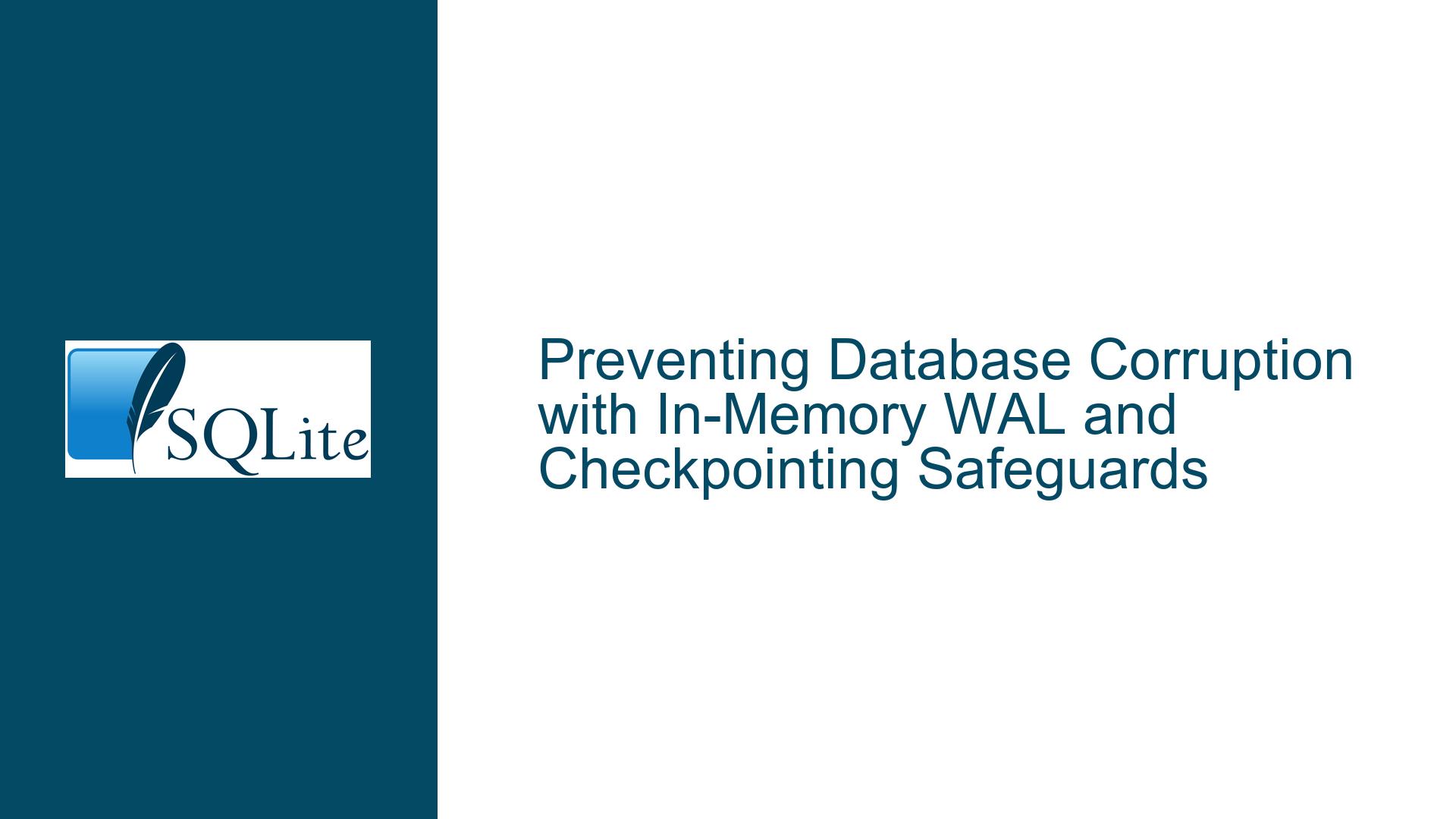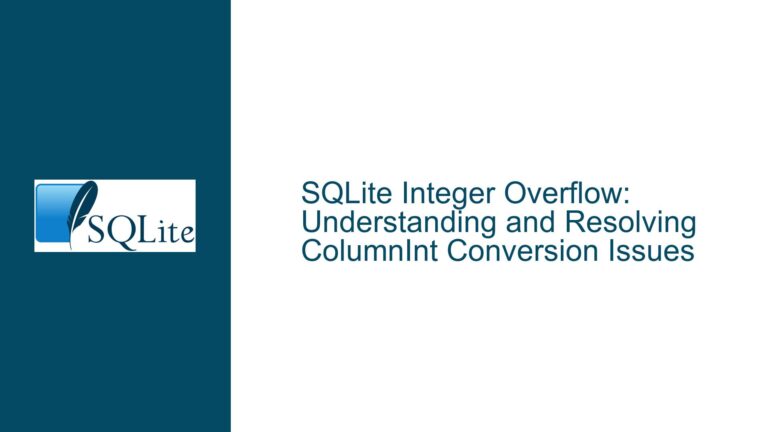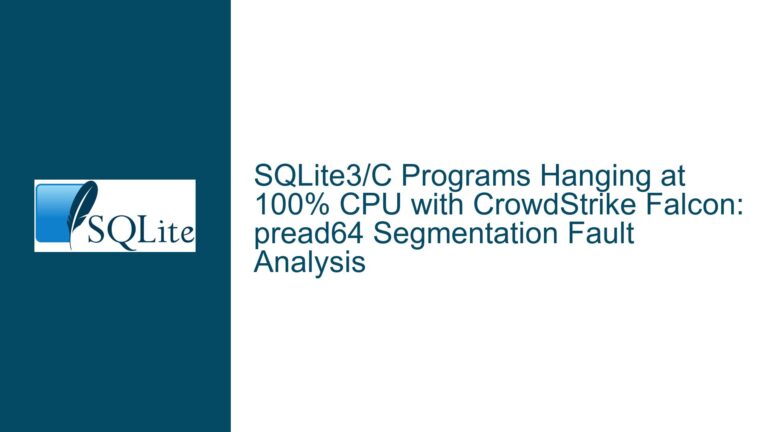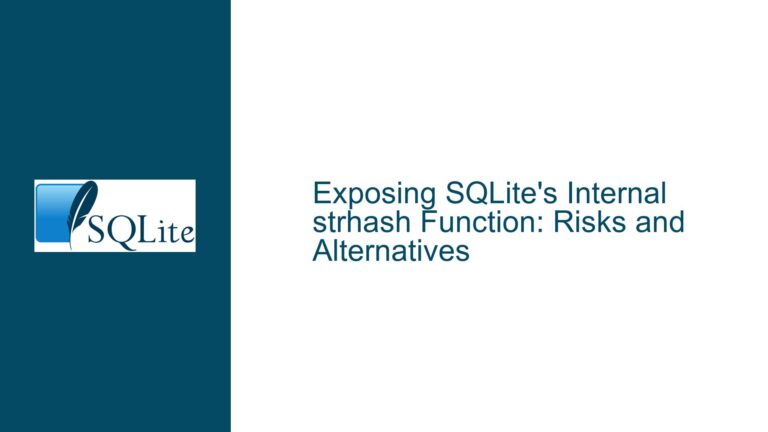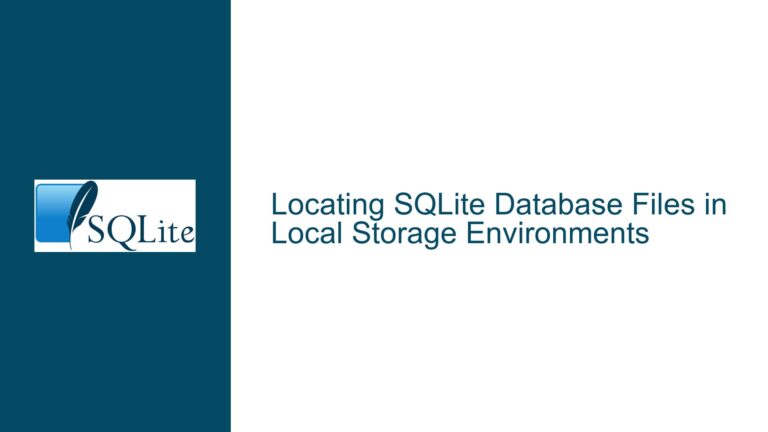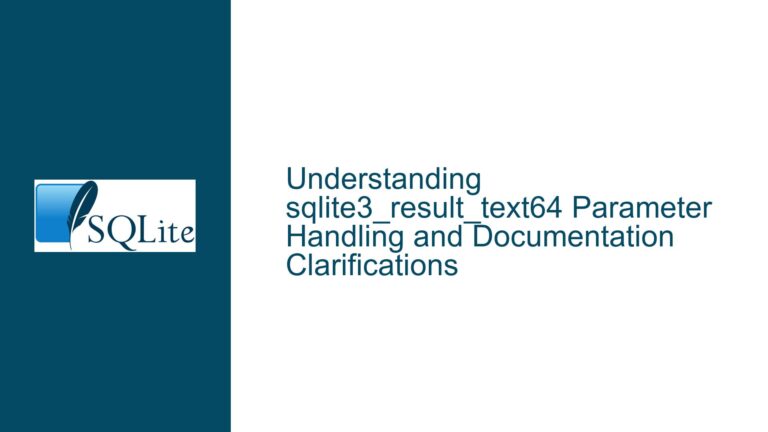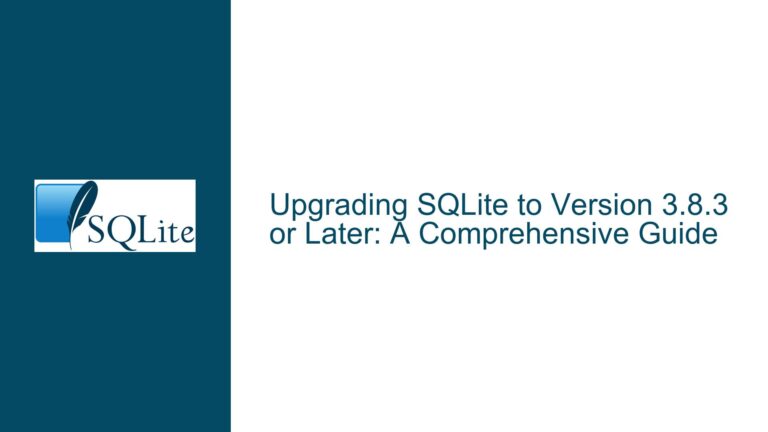Preventing Database Corruption with In-Memory WAL and Checkpointing Safeguards
Understanding the Risks of In-Memory WAL and Forceful Drive Ejection During Checkpointing
The core challenge revolves around leveraging SQLite’s Write-Ahead Logging (WAL) mode while storing the WAL file in memory instead of on disk. This approach aims to mitigate corruption risks caused by abrupt drive ejection during checkpointing operations. When the WAL resides in memory, SQLite avoids reading modified pages from disk, which reduces exposure to filesystem-level inconsistencies. However, checkpointing—the process of transferring changes from the WAL to the main database file—introduces a critical vulnerability: if the drive is forcefully ejected during this operation, the main database file may be left in a corrupted state. The goal is to ensure that even if checkpointing is interrupted, the original database remains intact and recoverable. This requires understanding SQLite’s checkpointing mechanics, the role of WAL files, and how to implement safeguards for transient storage devices.
Key Failure Modes: In-Memory WAL, Checkpointing, and Filesystem Assumptions
1. WAL File Dynamics in SQLite
In WAL mode, transactions are written to the WAL file first, and the main database file is updated asynchronously via checkpointing. The WAL file acts as a buffer, allowing concurrent reads and writes. When stored in memory, the WAL is ephemeral, meaning uncheckpointed transactions are lost if the application crashes. However, the primary risk here is not transaction durability but ensuring that checkpointing itself does not corrupt the main database if interrupted.
2. Checkpointing Mechanics
Checkpointing involves copying pages from the WAL to the main database file. SQLite supports automatic and manual checkpointing. Disabling auto-checkpointing (via sqlite3_wal_autocheckpoint(0)) allows checkpointing to occur only when explicitly triggered, such as when connections close. If the checkpointing process is interrupted—for example, by ejecting the drive—the main database file may end up with partial updates. Unlike traditional rollback journals, the WAL does not inherently provide atomicity for checkpointing. A partially applied checkpoint leaves the database in an inconsistent state.
3. Filesystem Vulnerabilities on Ejectable Drives
FAT filesystems (common on removable drives) lack atomic write guarantees, making them prone to corruption during sudden removal. When checkpointing writes to the main database file, the filesystem may cache these writes, leading to incomplete flushes. If the drive is ejected before the OS flushes cached data, the database file’s metadata (e.g., page counts, freelist) may reflect incomplete changes. SQLite’s documentation explicitly warns that deleting a hot journal (or interrupting WAL checkpointing) can corrupt the database.
4. Shim VFS Limitations
A custom VFS layer that redirects WAL operations to memory introduces complexity. While it avoids disk-based WAL writes, the shim must correctly handle checkpointing to the main database file. If the shim does not coordinate with SQLite’s internal state management, checkpointing may misalign WAL offsets or page numbers, leading to logical corruption. Additionally, the shim must ensure that the in-memory WAL is not prematurely garbage-collected or overwritten during concurrent access.
Solutions: Atomic Checkpointing, WAL File Management, and Recovery Safeguards
1. Two-Phase Checkpointing with Atomic File Replacement
Instead of checkpointing directly to the main database file, use a temporary copy of the database. The process would be:
- Phase 1: Checkpoint the in-memory WAL to a temporary database file (e.g.,
main.db.tmp). - Phase 2: Replace the original
main.dbwithmain.db.tmpusing an atomic filesystem operation (e.g.,rename()on Unix orMoveFileExon Windows).
This ensures that the original database is either fully replaced or left untouched, avoiding partial updates. However, this requires sufficient disk space for a full copy and support for atomic renames on the target filesystem.
2. Write-ahead Journaling for Checkpoint Operations
Treat the checkpointing process itself as a transaction. Before checkpointing begins:
- Create a temporary journal file (e.g.,
main.db-checkpoint-journal) on the ejectable drive. - Write metadata (e.g., checksums, page counts) to this journal.
During checkpointing, periodically update the journal with progress markers.
If the drive is ejected mid-checkpoint, the journal can be used to revert the database to its pre-checkpoint state using the saved metadata. This mimics SQLite’s rollback journal mechanism but applies it to the checkpointing phase.
3. Delayed WAL File Materialization
The original proposal suggested creating a "fake" WAL file on disk before checkpointing. To implement this:
- Prior to checkpointing, write a minimal valid WAL header to disk (e.g., 32-byte header with a valid checksum and initial frame count of 0).
- Store the in-memory WAL’s content in a separate buffer.
- During checkpointing, append the in-memory WAL frames to the on-disk WAL file while simultaneously applying them to the main database.
If the drive is ejected mid-checkpoint, the on-disk WAL file will contain enough information for SQLite to recognize it as a valid (albeit incomplete) WAL. Upon reopening, SQLite will attempt to recover using the on-disk WAL, which would either complete the checkpoint or roll back uncommitted transactions. This approach requires careful synchronization between the in-memory buffer and the on-disk WAL.
4. Checksum Validation and Partial Checkpoint Recovery
Extend SQLite’s built-in page checksums to cover checkpointing progress. After each batch of pages is written to the main database during checkpointing, update a checkpoint-specific checksum stored in the database header. If the drive is ejected, upon remounting, the application can scan the database to find the last valid checksum and truncate the database to that point. This requires customizing SQLite’s checkpoint logic to include checksum updates and recovery routines.
5. Filesystem Flush Coordination
Force the filesystem to flush all pending writes before signaling checkpoint completion. Use sqlite3_io_methods in the custom VFS to override the xSync method, ensuring that fsync() is called on both the main database and WAL file (if materialized) after checkpointing. Combine this with OS-specific APIs to disable write caching for the ejectable drive (e.g., IOCTL_DISK_SET_CACHE_INFORMATION on Windows). While this reduces performance, it minimizes the window for corruption.
6. Alternative Journal Modes and Eject Safeguards
Consider disabling WAL mode entirely and using DELETE journal mode with a delayed synchronization strategy. For example:
- Use
PRAGMA journal_mode=DELETE; - Disable synchronous writes (
PRAGMA synchronous=OFF;) but manually callsqlite3_db_cacheflush()before signaling that the drive is safe to eject.
This trades transaction durability for reduced corruption risk. However, this approach may not meet ACID requirements for all use cases.
7. Userland Checkpoint Coordination
Implement a lease-based system where the application locks a file on the ejectable drive during checkpointing. The eject handler in the OS (or a custom driver) checks for this lock before allowing ejection. If the lock is present, the ejection is delayed or a warning is shown. This requires platform-specific integration but provides a user-facing safeguard.
8. SQLite Backup API as a Checkpoint Alternative
Use sqlite3_backup_init() to create an online backup of the database to a temporary file. Once the backup is complete, atomically replace the original database. This leverages SQLite’s built-in backup logic, which handles concurrency and partial writes. The backup process is inherently atomic from the perspective of the target file, as it is written in a single transaction.
Final Considerations
- Durability vs. Integrity: The proposed in-memory WAL strategy prioritizes database integrity over transaction durability. Ensure stakeholders accept that uncheckpointed transactions may be lost.
- Testing: Use fault injection tools (e.g.,
FaultyVFS in SQLite’s test suite) to simulate drive ejections and validate recovery mechanisms. - Platform Constraints: Atomic rename operations and filesystem flushes may behave differently across OSes. Test thoroughly on target platforms.
- Performance: In-memory WAL reduces I/O but increases memory usage. Monitor for memory exhaustion in scenarios with large transactions.
By combining atomic file operations, checkpoint journaling, and recovery safeguards, it is possible to mitigate corruption risks while leveraging in-memory WAL for performance and concurrency.
